Anatomy and Physiology 2 Lecture Exam Two From Test Bank
1/111
There's no tags or description
Looks like no tags are added yet.
Name | Mastery | Learn | Test | Matching | Spaced |
|---|
No study sessions yet.
112 Terms
The specific foreign substances that an individualʹs immune system has the ability to recognize
and resist is determined by?
D, individual genetic makeup
The bodyʹs first line of defense against the invasion of disease-causing microorganisms is?
B, skin and mucous membranes
Which of these lymphoid organs is found along the left side of the abdominal cavity?
E, Spleen
Which one of the following is NOT an autoimmune disease?
A, AIDS
Which one of the following is NOT true of macrophages?
C, they circulate continuously throughout the body
Describe the flow of lymph.
A, Toward the heart only
Which one of the following is NOT one of the four most common indicators of the inflammatory
response?
E, fever
Regardless of whether it matures into a B cell or a T cell, a lymphocyte that is capable of responding to a
specific antigen by binding to it is said to be?
A, immunocompetent
Allergic contact dermatitis following skin contact with poison ivy would normally lead to?
D, delayed hypersensitivity
The specific type of acquired immunity that a fetus obtains from maternal antibodies that cross
the placenta is called?
C, naturally acquired passive immunity
Which one of the following is NOT a mechanism that aids lymph return?
A) smooth muscle contractions within the lymphatic vessels
B) milking action of skeletal muscles
C) pressure changes within the thorax
D) the pumping action of the heart
E) presence of valves within the larger lymph vessels
D, the pumping action of the heart
The bodyʹs temperature-regulating ʺthermostatʺ that can be reset upward in response to
pyrogens is located in the?
E, hypothalamus
The specific antibody class that has the ability to cross the placental barrier and provide
immunity to the fetus is?
A, IgG
The inflammatory process begins with release of chemicals, which do all of the following
EXCEPT?
E, Stimulate release of lysozyme
Compared to the nonspecific chemicals that cover body surfaces and mucous membranes, the
specific body defense system is?
B, Slower
Which one of the following is NOT true of basic antibody structure?
E, the light chains are often differing lengths
Which one of the following is NOT a type of immunosuppressive therapy given after surgery to
prevent rejection of a graft?
B, gamma globulin
Vaccines are NOT for?
A, snake bites
B cells develop immunocompetence in the?
B, bone marrow
Which one of the following CANNOT be said about the history of immunity?
C, scientists of the mid1900s discovered the viral origin of AIDS
The relatively common autoimmune disease in which the thyroid gland produces excessive amounts of thyroxine is called?
A, Grave's disease
Antigen presentation is essential for the activation and clonal selection of?
E, T cells
Which of the following substances is NOT typically perceived as an antigen?
A) pollen grains
B) virus particles
C) fungi
D) self-antigens
E) bacteria
D, self-antigens
Musoca-associated lymphatic tissue (MALT) includes?
B, tonsils and Peyer's patches
Lymph from the left arm would return to the heart through the?
A, Thoracic duct
The process by which neutrophils are squeezed through the capillary walls during the
inflammatory process is called?
B, diapedesis
Which one of the following is NOT a method by which antibodies inactivate antigens?
B, chemotaxis
Which one of the following is NOT a type of lymphoid organ?
A) spleen
B) thymus gland
C) Peyerʹs patches
D) appendix
E) tonsils
D, appendix
Immune sera are used for all of the following EXCEPT?
A, tuberculosis
The process by which antibodies bind to specific sites on bacterial exotoxins (toxic chemicals
secreted by bacteria) to block their harmful effects is called?
D, Neutralization
Which one of the following is NOT true of lymph nodes?
D, they have valves similar to those found in veins
Which one of the following is NOT one of the antibody classes?
C, IgB
The lymph organ that programs T cells and functions at peak levels only during youth is the?
B, thymus
An isograft is a tissue graft donated by?
B, an identical twin
The fluid that is forced out of the capillary beds by hydrostatic and osmotic pressures and into
the tissue spaces is called?
E, lymph
Which lymphoid tissues trap and remove bacteria entering the throat?
B, tonsils
Which one of the following is NOT one of the nonspecific body defenses?
A, antibody production
IgA:
A) is passed from mother to fetus during pregnancy
B) is involved in allergies
C) is the most abundant antibody in blood plasma
D) can fix complement
E) is mainly found in mucus and secretions such as tears and saliva
E, is mainly found in mucus and secretions such as tears and saliva
Fever has the effect of doing all of the following EXCEPT?
C, stimulating complement fixation
The migration of phagocytes and white blood cells to an inflamed area along a chemical gradient
is called?
E, Chemotaxis
Tissues invaded by viruses, which attempt to replicate themselves by taking over cellular
machinery, secrete small proteins called __________ to protect nearby cells and hinder further
multiplication of the viruses.
E, interferon
What specific type of acquired immunity do vaccines provide?
D, artificially acquired active immunity
Which one of the following is NOT true of the constant (C) regions of antibodies?
D, they form an antigen-binding site
With immediate hypersensitivy, the antibody class that binds to mast cells and basophils that
trigger the release of histamine and other chemicals is?
A, IgE
The study of immunity is called?
C, immunology
The lymph tissues found within the walls of the small intestine are called?
A, Peyer's patches
Which lymphatic organʹs major job is to destroy worn-out red blood cells and return some of the
products to the liver?
E, spleen
Antibodies constitute an important part of blood proteins and are also referred to as
__________.
immunoglobulins
Antigens that produce abnormally vigorous immune responses whereby the immune system causes tissue damage as it fights off a perceived threat that would otherwise be
harmless are called __________.
allergens or hypersensitivities
Systemic (bodywide) acute allergic response caused by allergens that directly enter the
blood, as with certain bee stings or spider bites, is called __________.
anaphylactic shock
Cells studded with protein molecules found on our own cells that do not trigger an
immune response within us (but may within others) are called __________.
self-antigens (autoantigens)
The fibrous capsule of lymph nodes contains strands called __________ that divide the compartments.
trabeculae
(since I can't add pictures to the front of a card I will flip the next section)
The Peyerʹs patches are indicated by letter __________. (answer on front of next card)
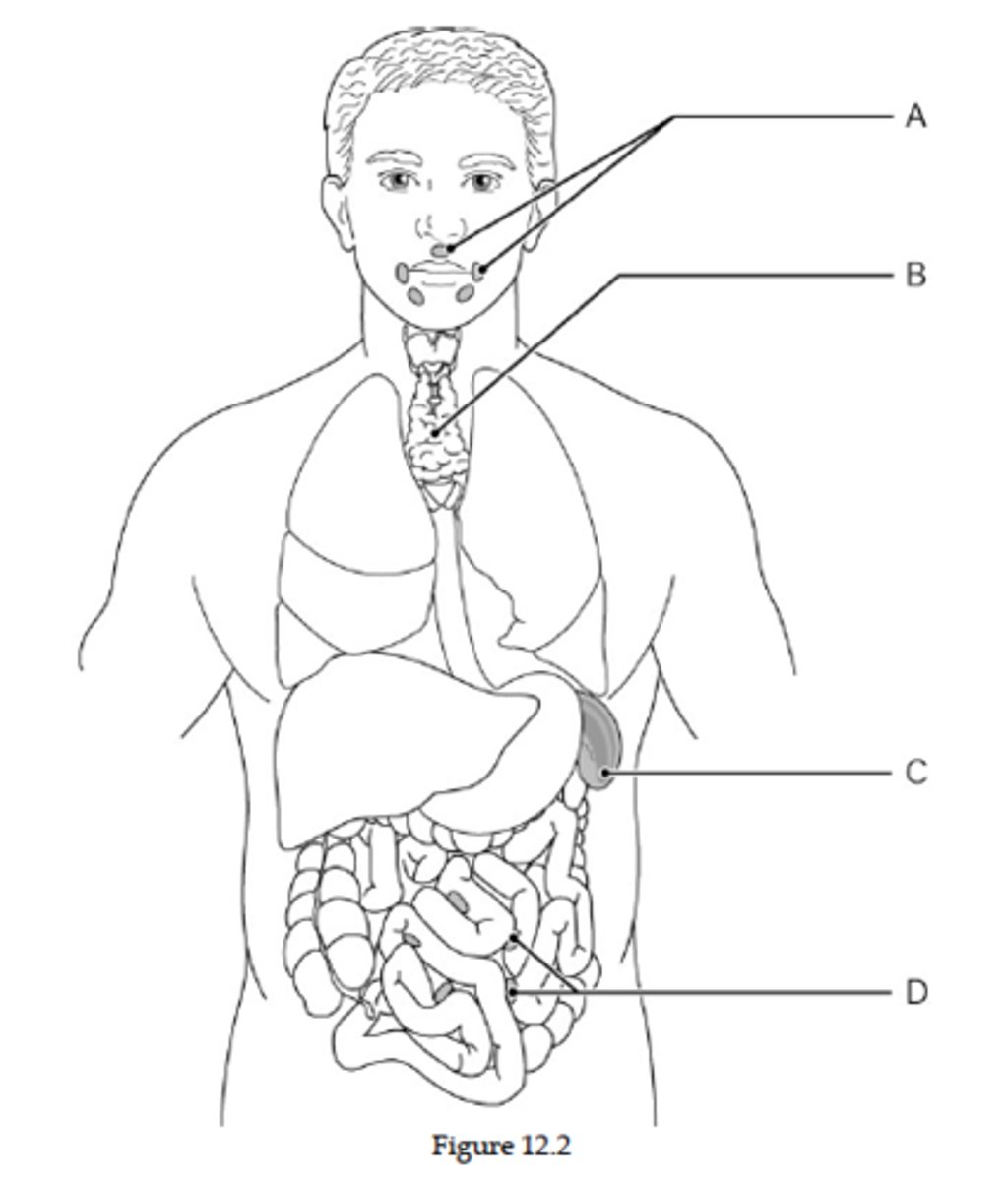
(D) (see back of card)
Troublesome small molecules or incomplete antigens that may mount an attack that is
harmful rather than protective are called __________.
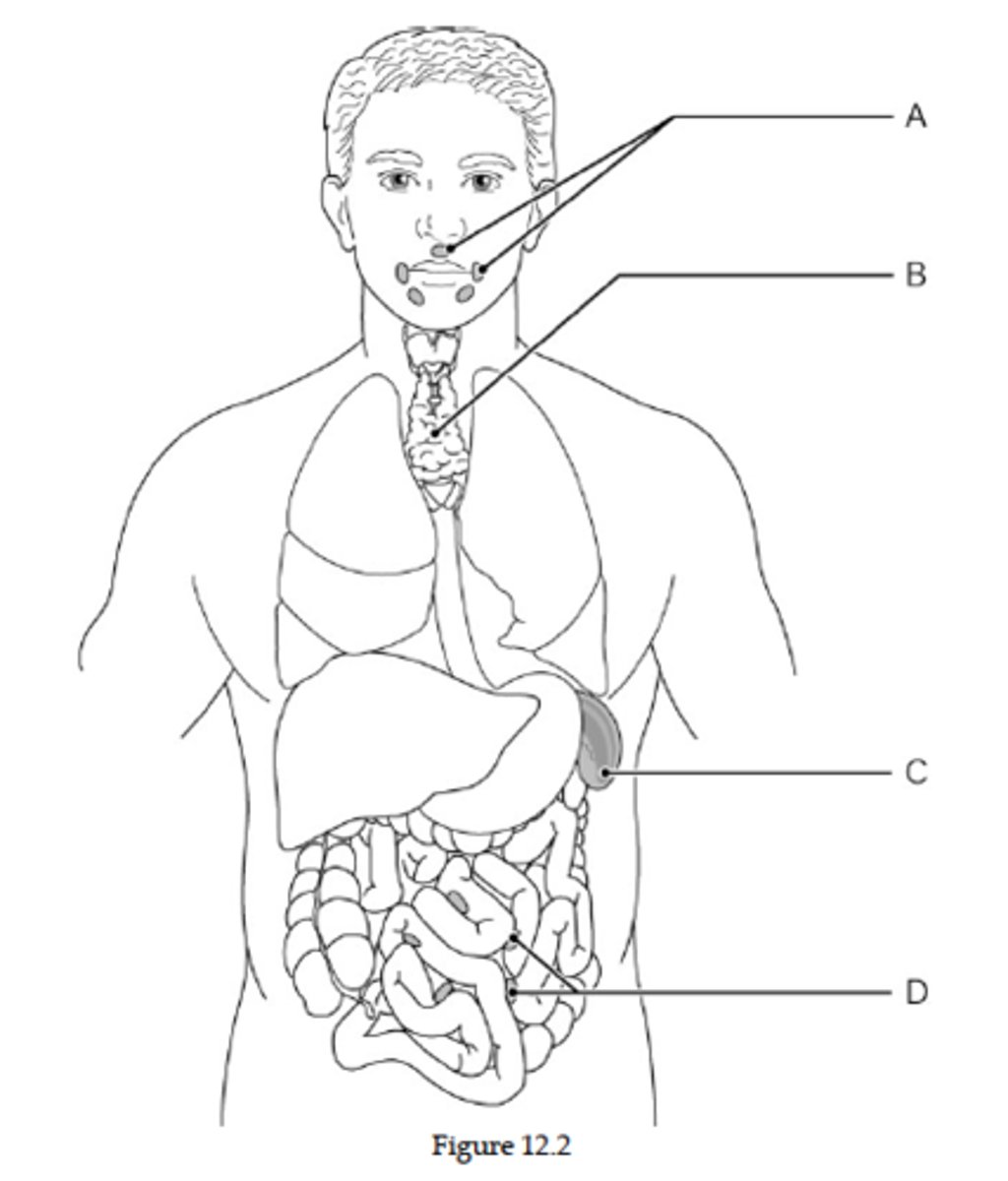
(haptens) (see back of card)
Peyerʹs patches and the tonsils are part of the collection of small lymphoid tissues that
protect the upper respiratory and digestive tracts from infection and are referred to as
__________.
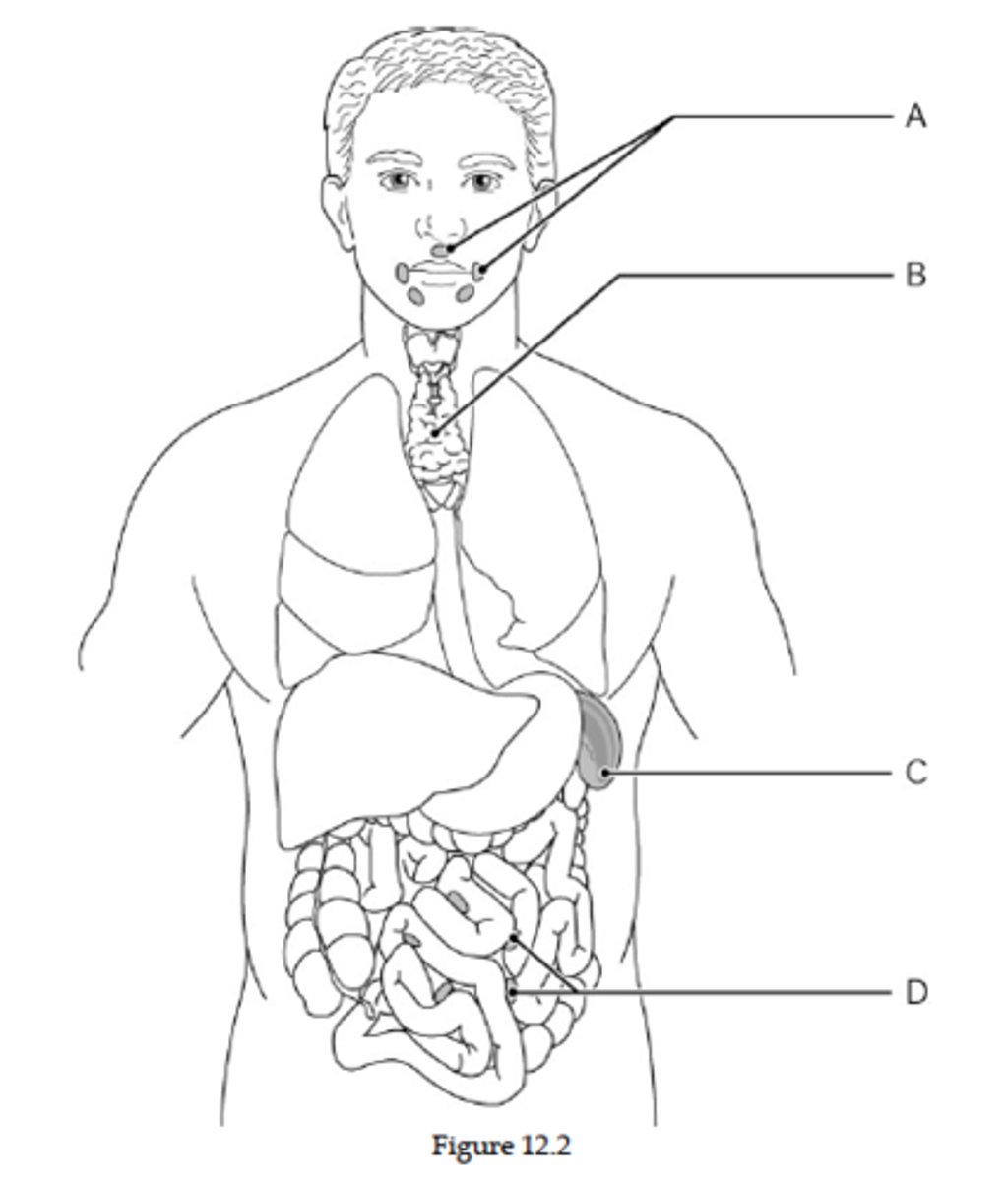
(MALT) (see back of card)
The lymph duct is indicated by lettter __________.
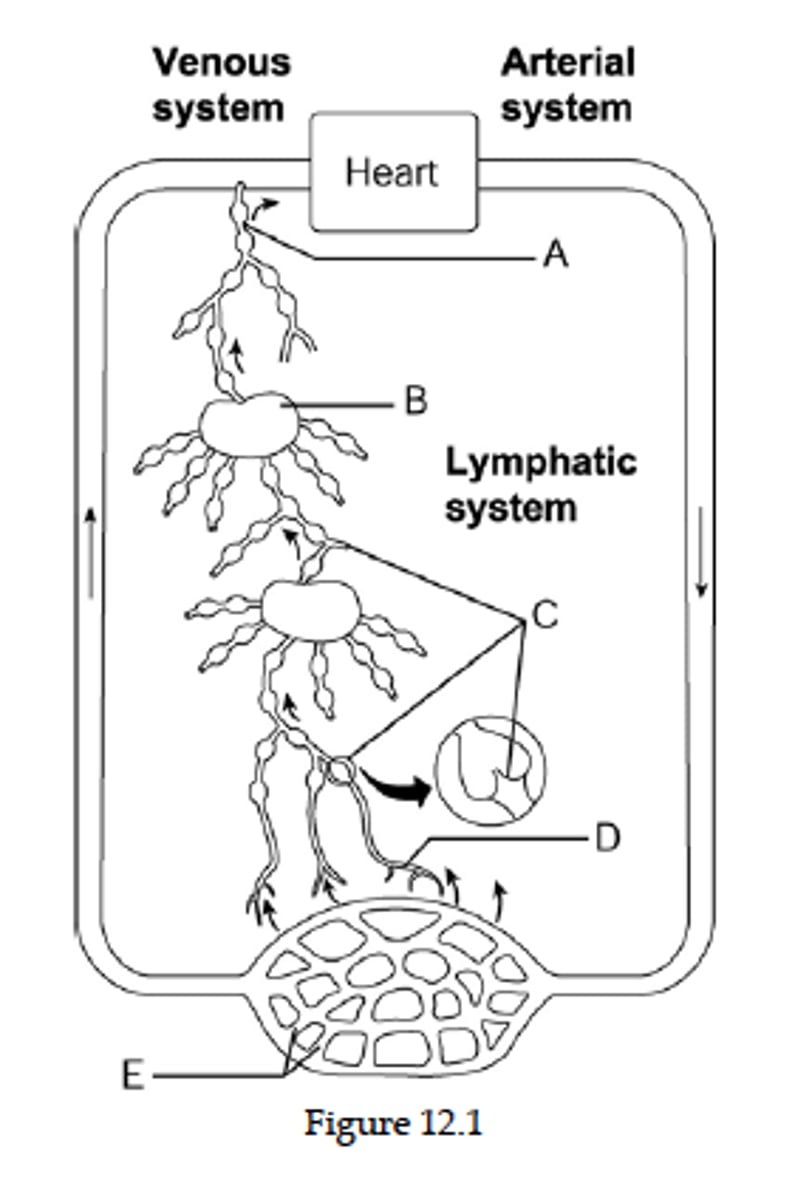
(A) (see back of card)
The role of the __________ in the lymphatic system is to remove worn-out blood cells
and return some of the products to the liver.
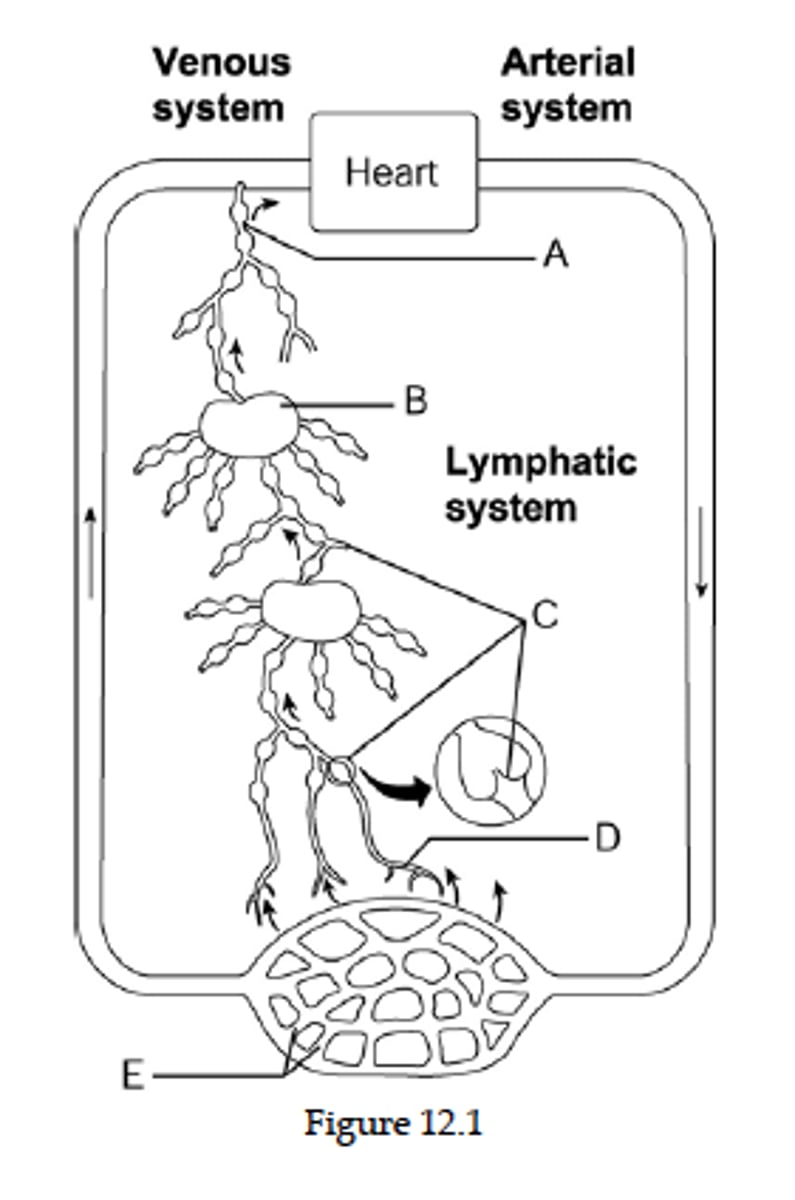
(Spleen) (see back of card)
The process by which WBCs and phagocytes migrate to an area experiencing acute
inflammation is called __________.
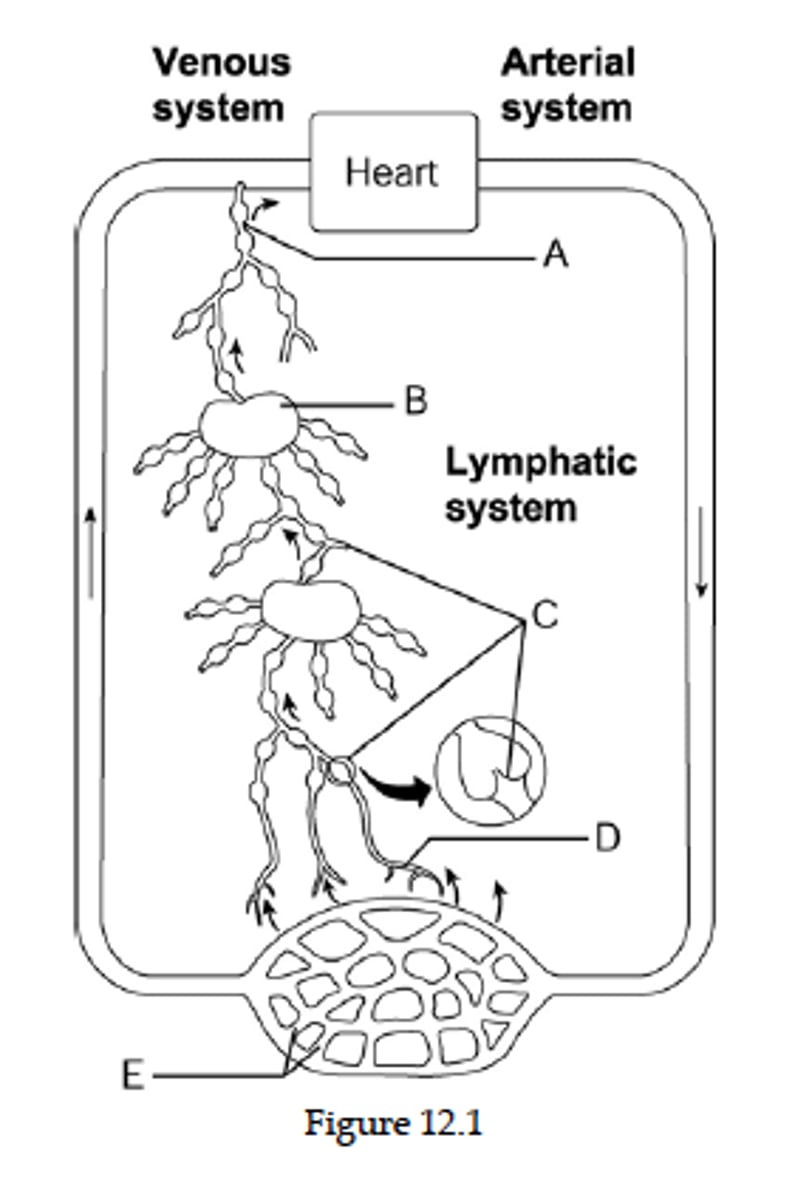
(Chemotaxis) (see back of card)
A lymph capillary is indicated by letter __________.
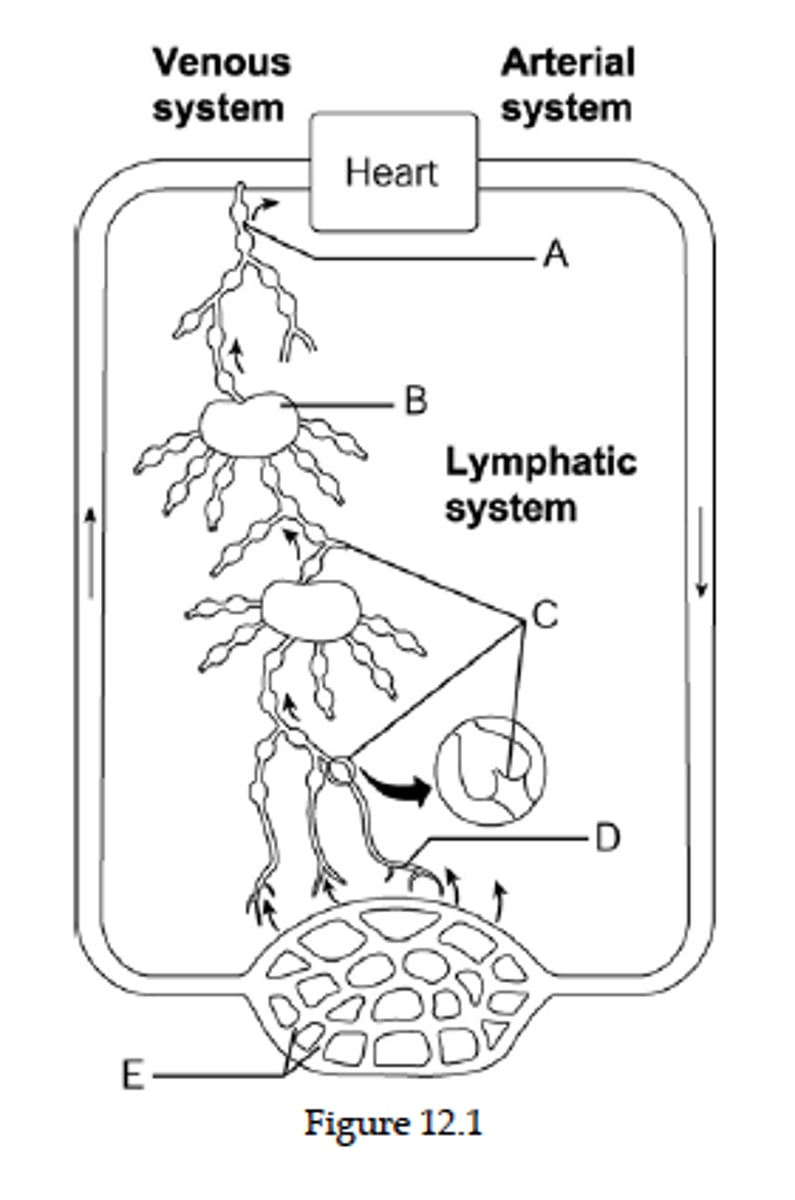
(D) (see back of card)
The thymus gland is indicated by letter __________.

(B) (see back of card)
Killer T cells, which kill virus-invaded body cells, are also called __________.
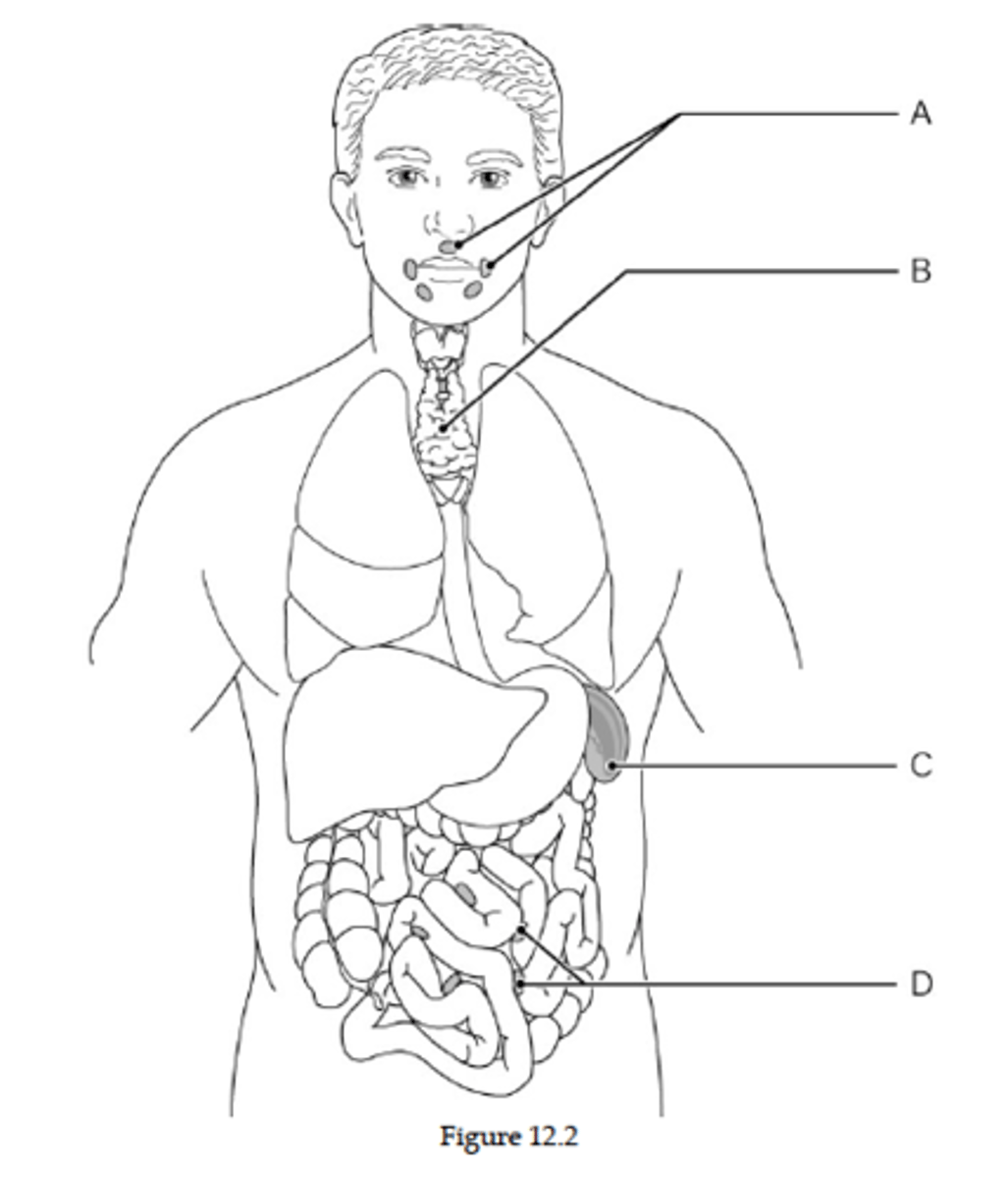
(Cytotoxic T cells) (see back of card)
When an antigen binds to B cell surface receptors, it becomes sensitized (activated) and
undergoes __________.
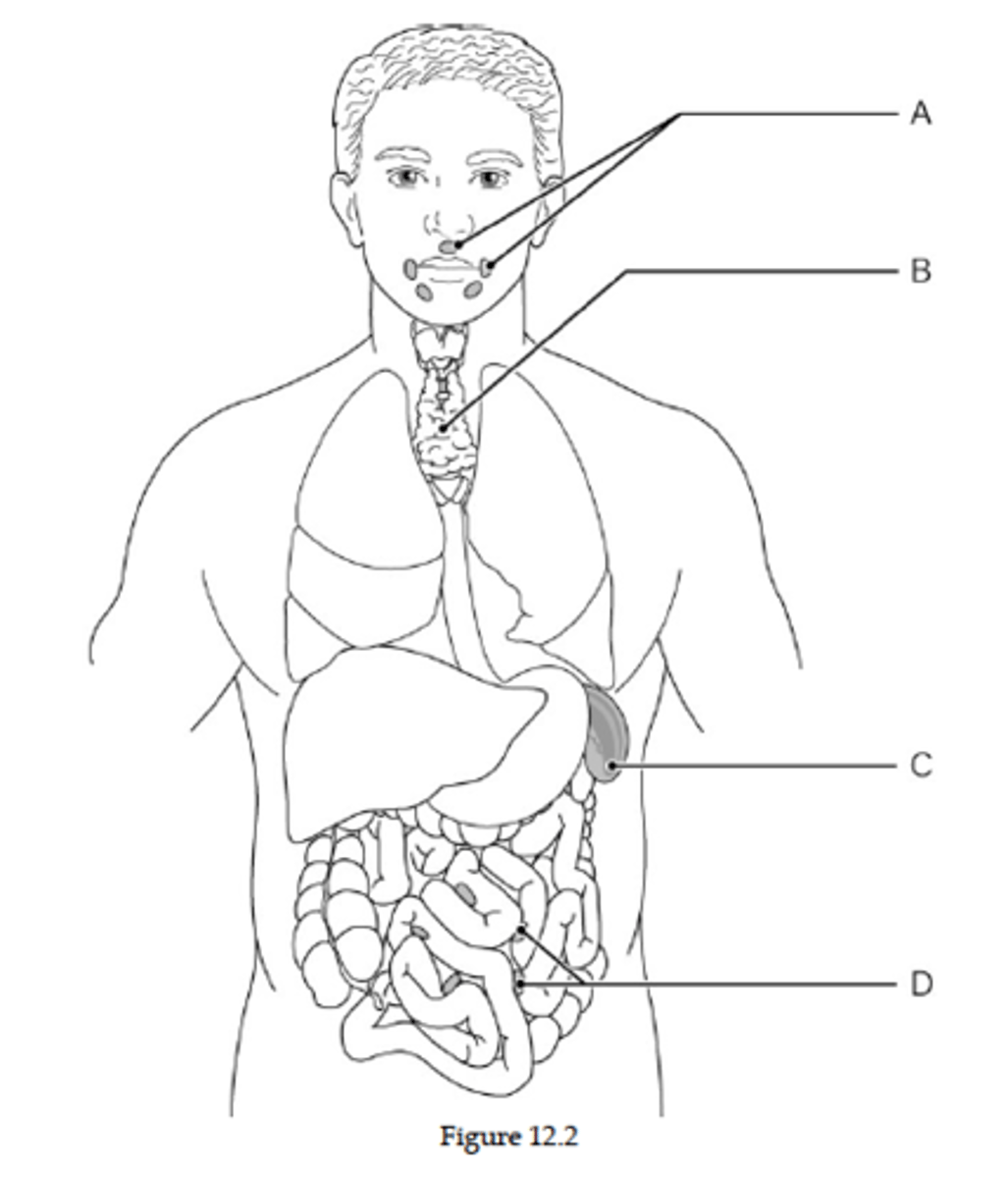
(clonal selection) (see back of card)
Blood capillaries are indicated by letter __________.
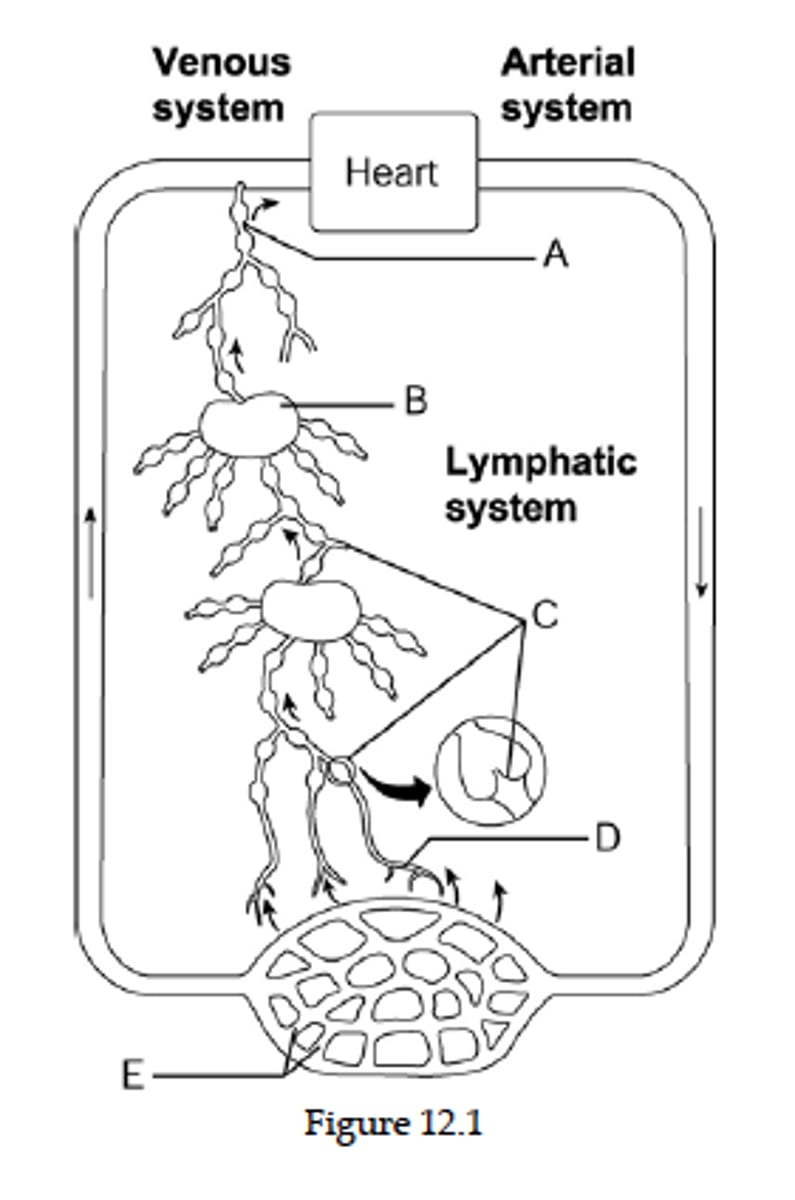
(E) (see back of card)
The lymphoid organ that destroys worn-out blood cells is indicated by letter
__________.
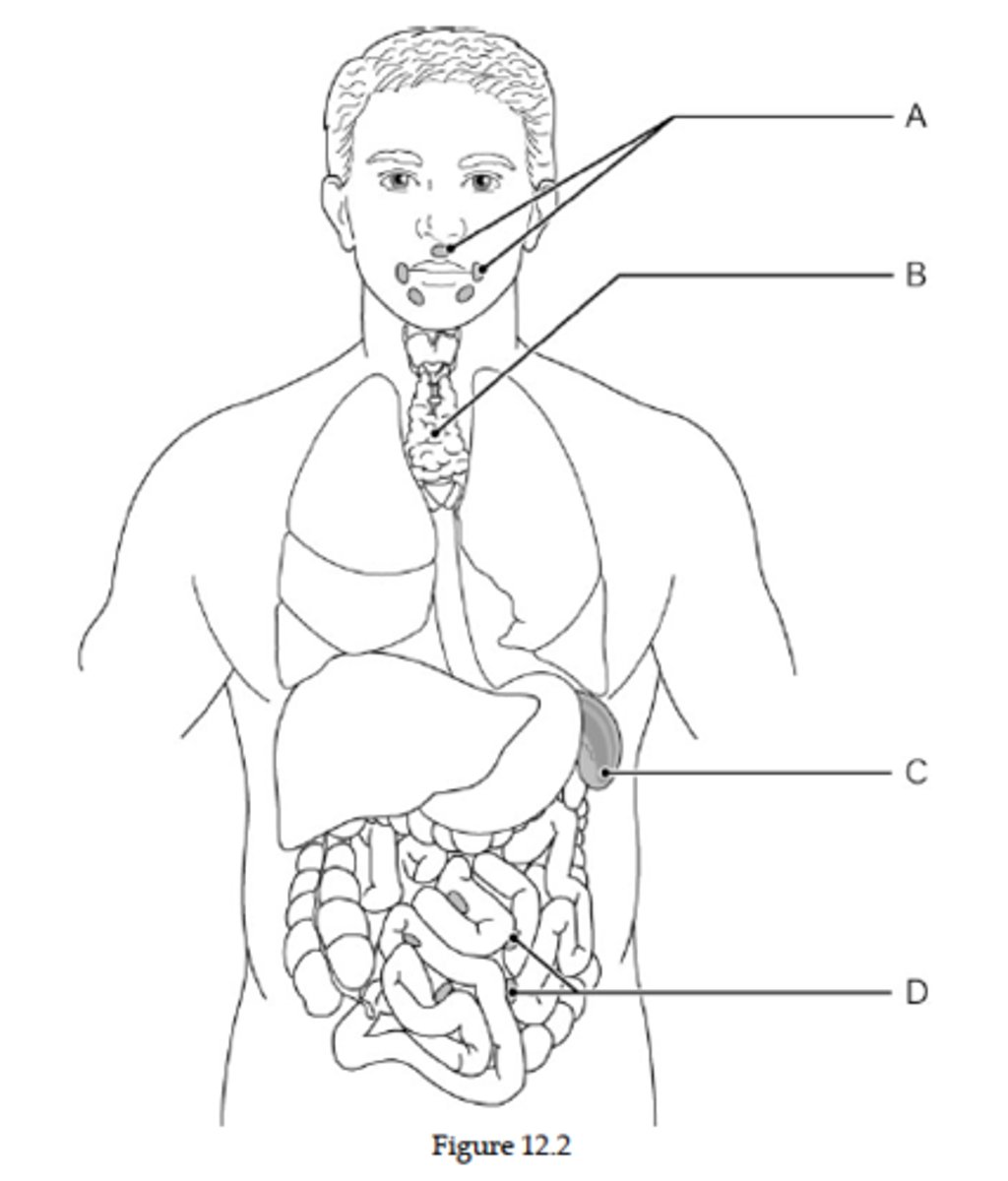
(C) (see back of card)
The binding of complement proteins to certain sugar or proteins on a foreign cellʹs
surface is called __________.
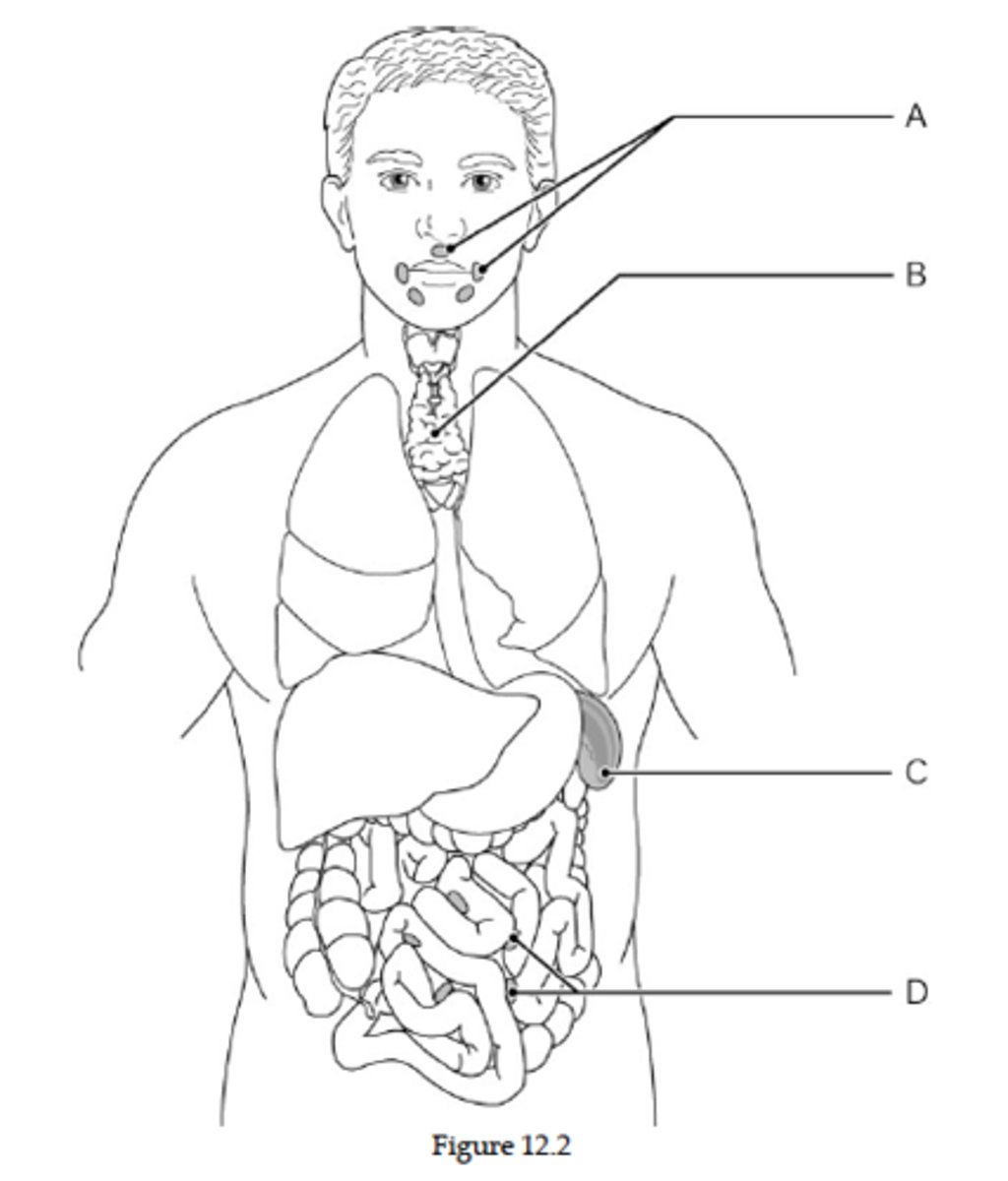
(Complement fixation) (see back of card)
The tonsils are indicated by letter __________.
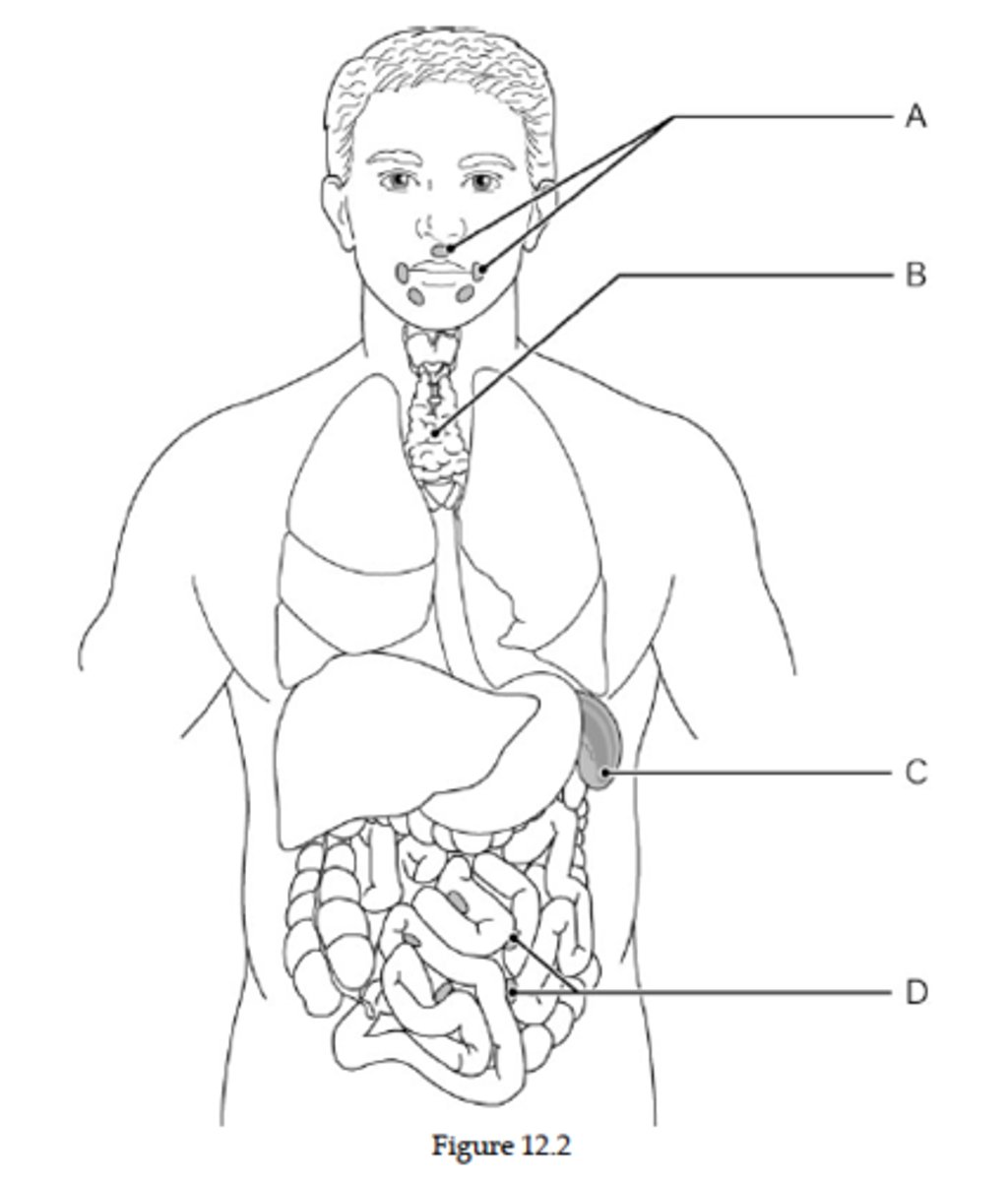
(A) (see front of next card)
(I will flip the cards back until it forces me to use pictures again)
Excess accumulations of fluid, which impair the exchange of materials within the tissues,
is called __________.
edema
When B cells encounter antigens and produce antibodies against them, we exhibit
__________.
active immunity
(I will flip the cards so that I can add pictures)
A lymph node is indicated by letter __________.
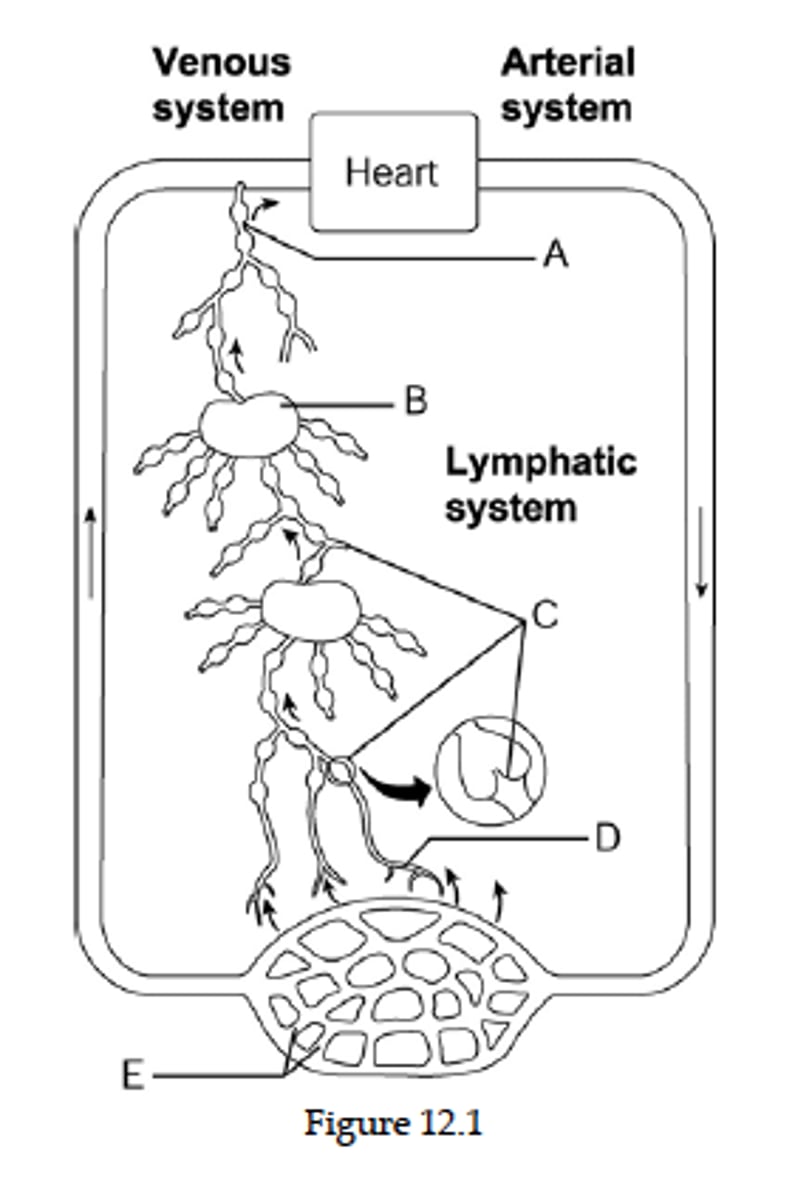
(B) (see back of card)
Lymph fluid and some plasma proteins originate (escape) from the __________.
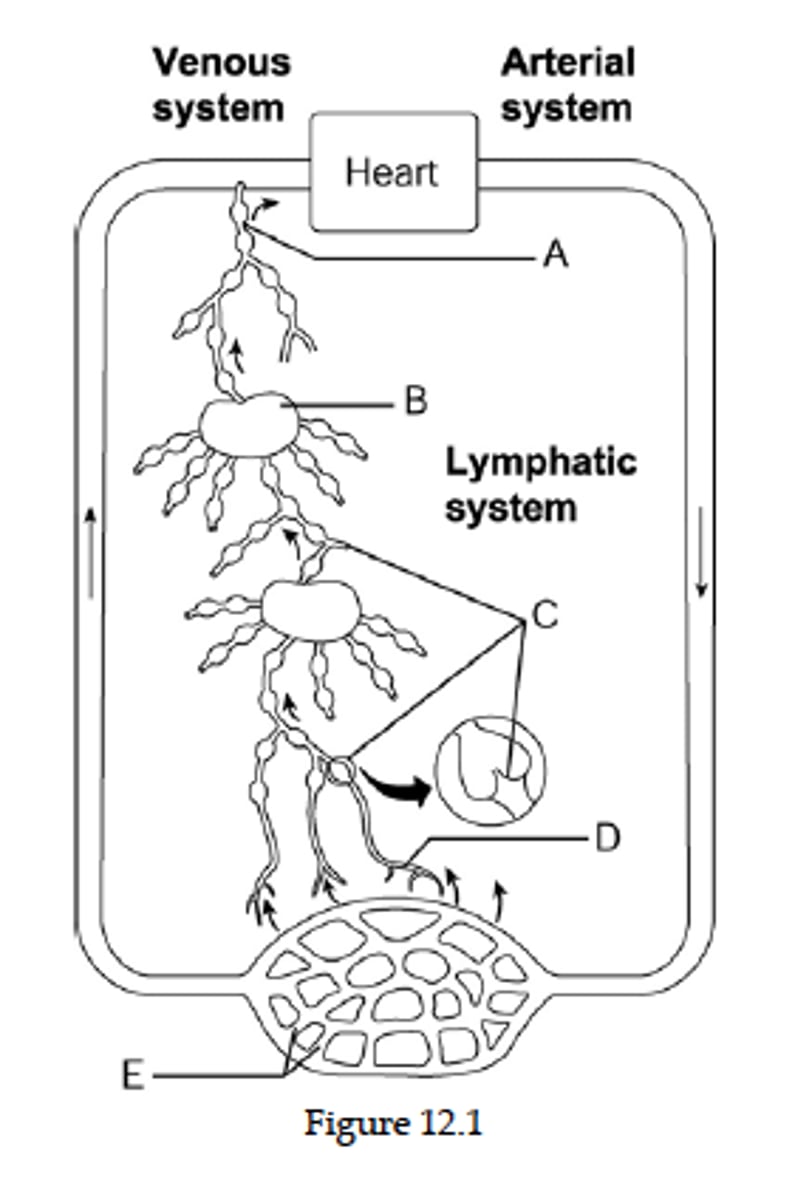
(blood plasma) (see back of card)
The five major immunoglobulin classes are __________.
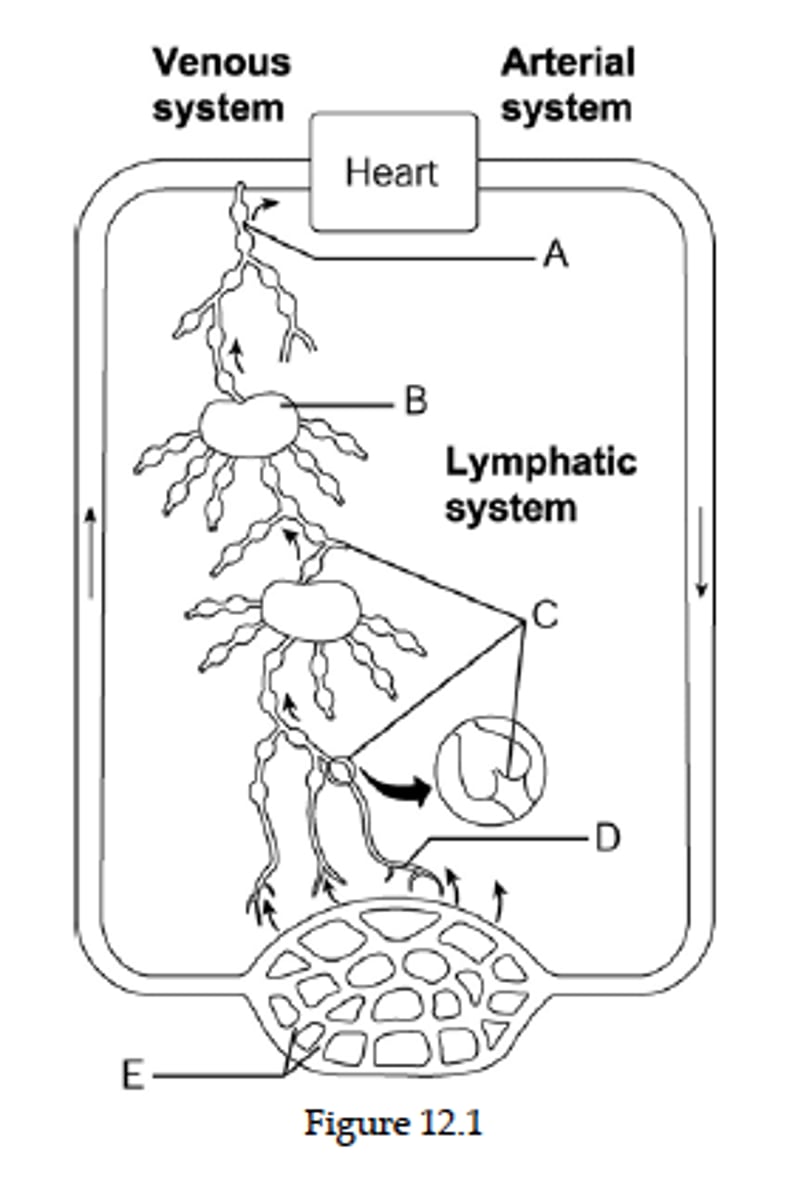
(IgM, IgA, IdD, IgG, IgE) (see back of card)
The process by which neutrophils squeeze through capillary walls is called __________.
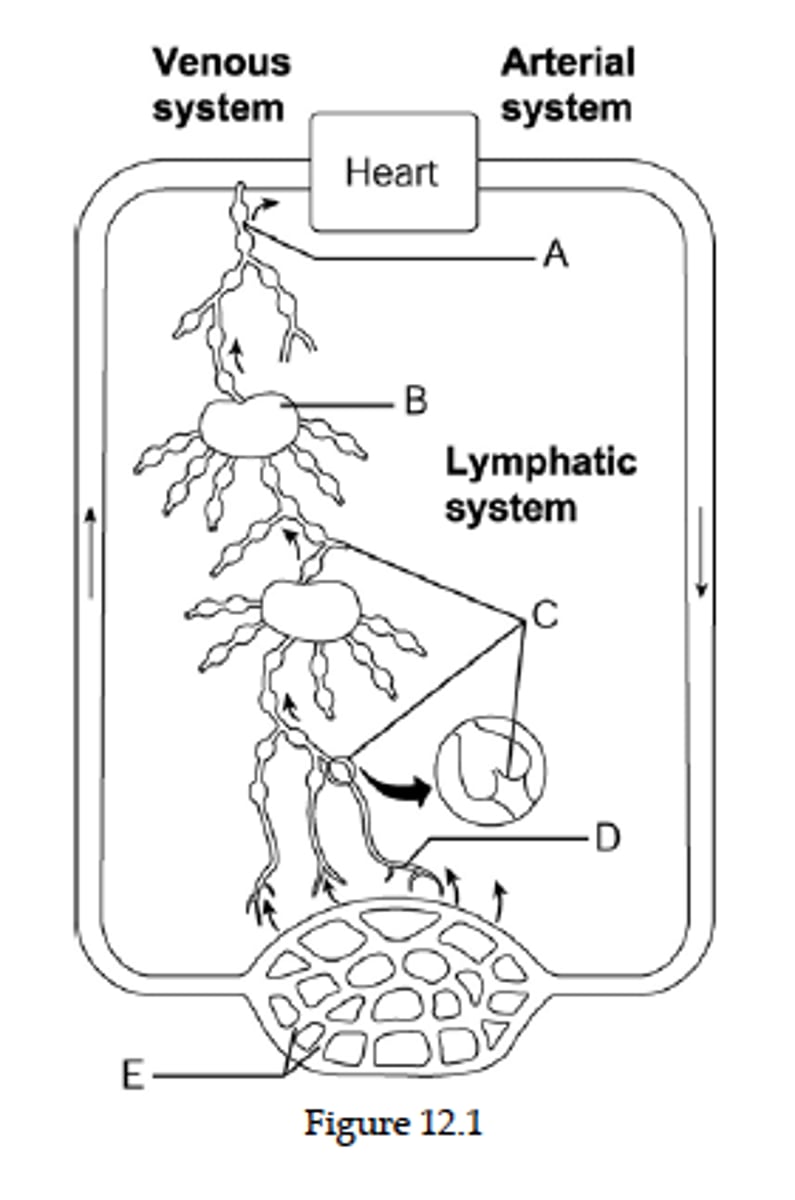
(Diapedesis) (see back of card)
The binding of antibodies to specific sites on bacterial exotoxins or viruses is called
__________.
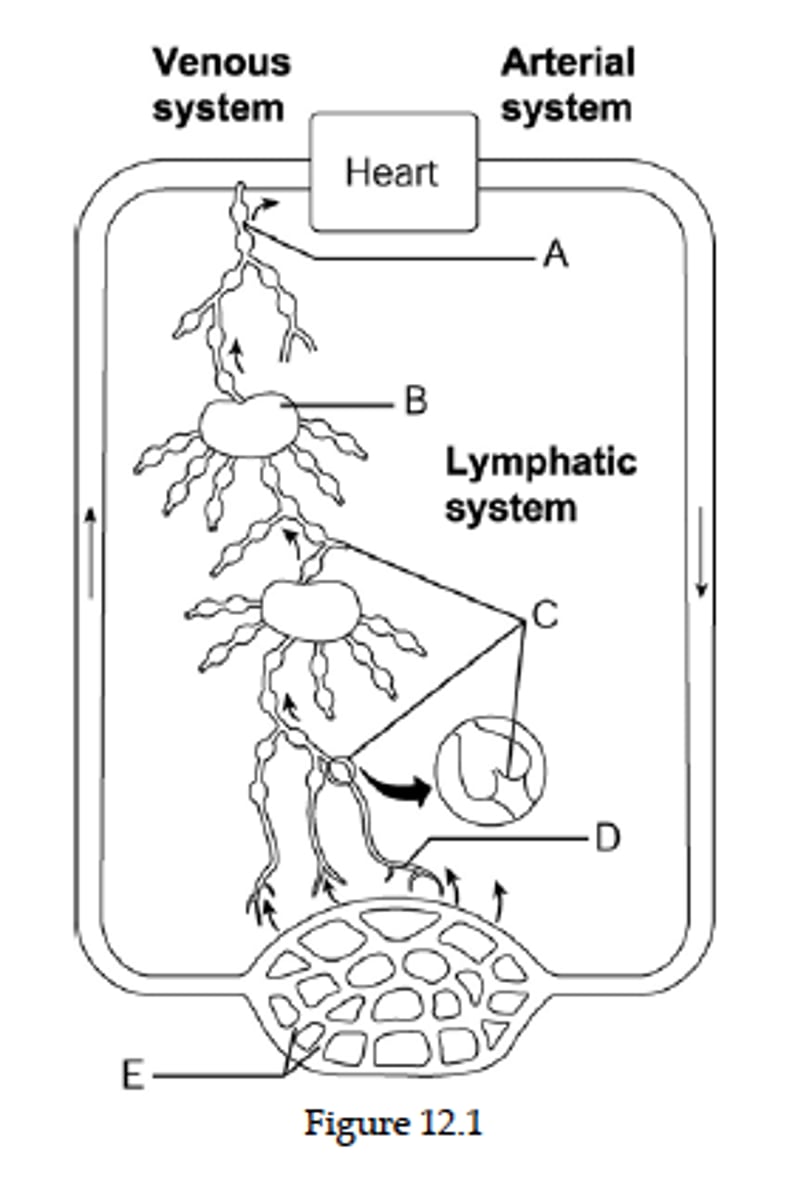
(neutralization) (see back of card)
Lymphatic collecting vessels are indicated by letter __________.
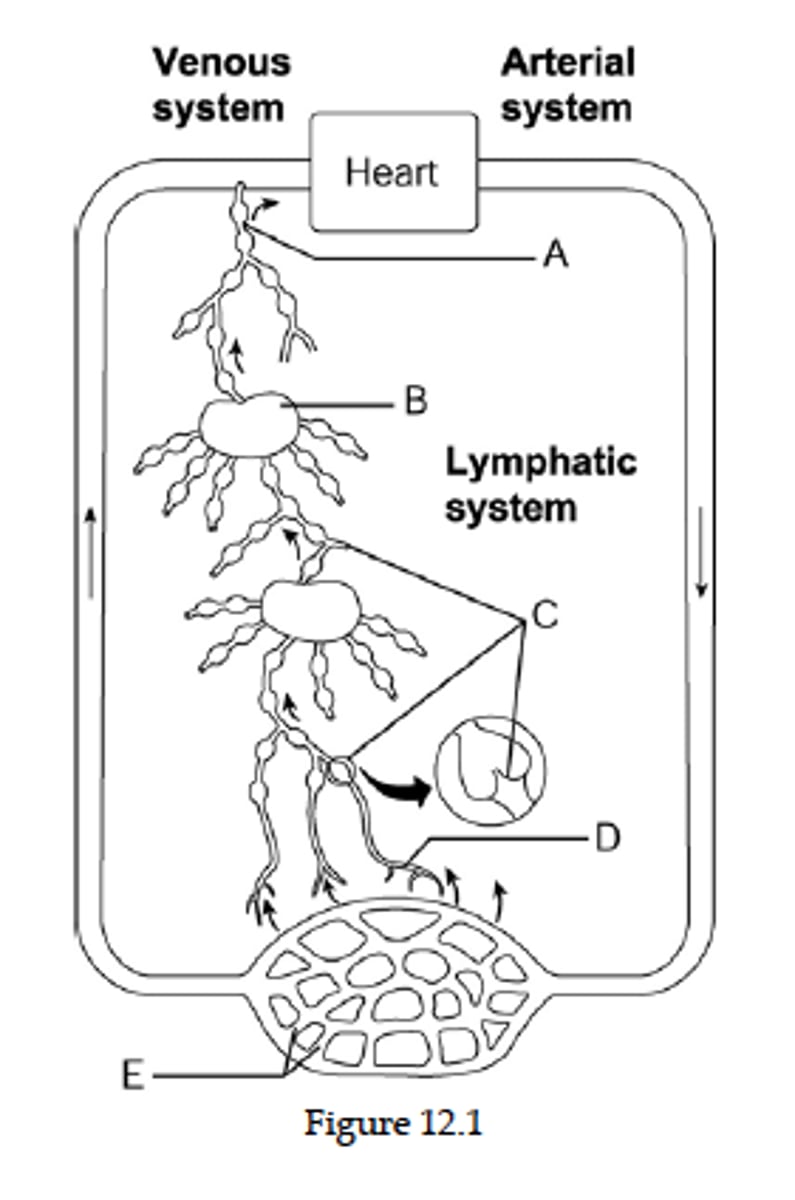
(C) (see back of card)
Harmful or disease-causing microorganisms from which nonspecific defenses protect
the body are called __________.
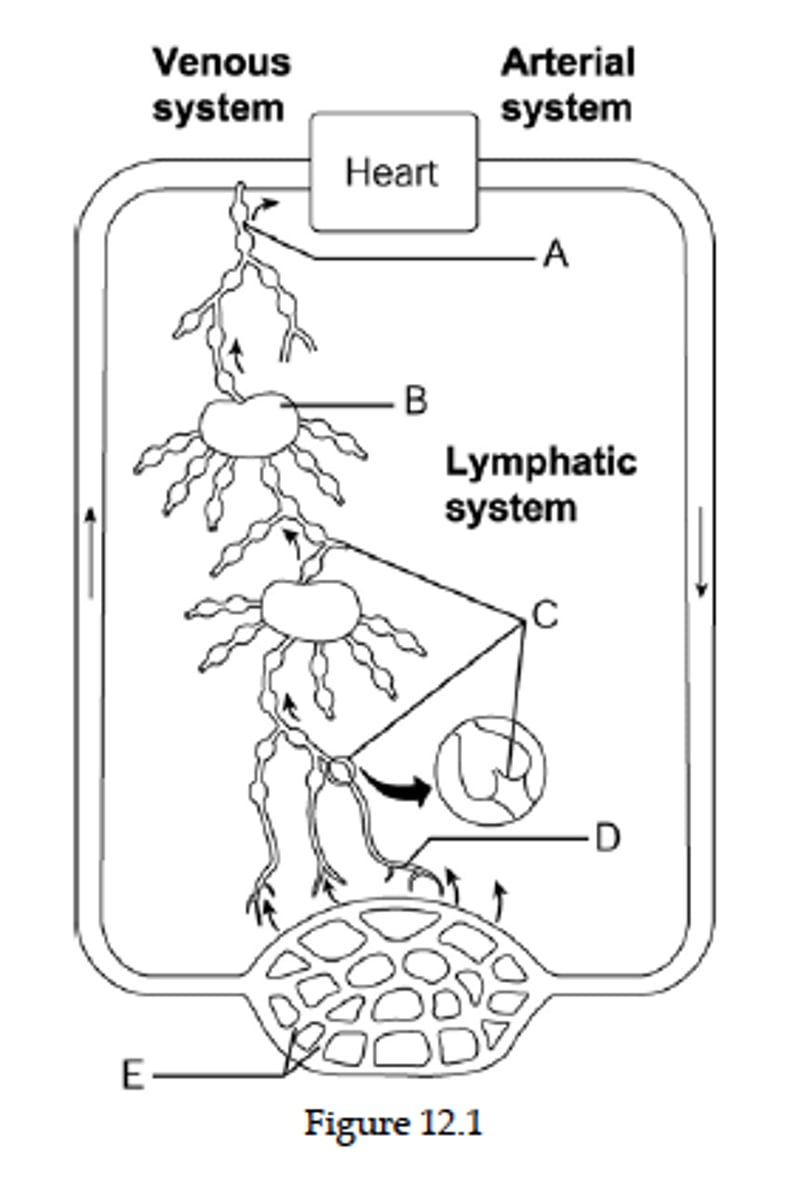
(Pathogens) (see back of card)
Lymph exits the lymph node via the __________ vessels.
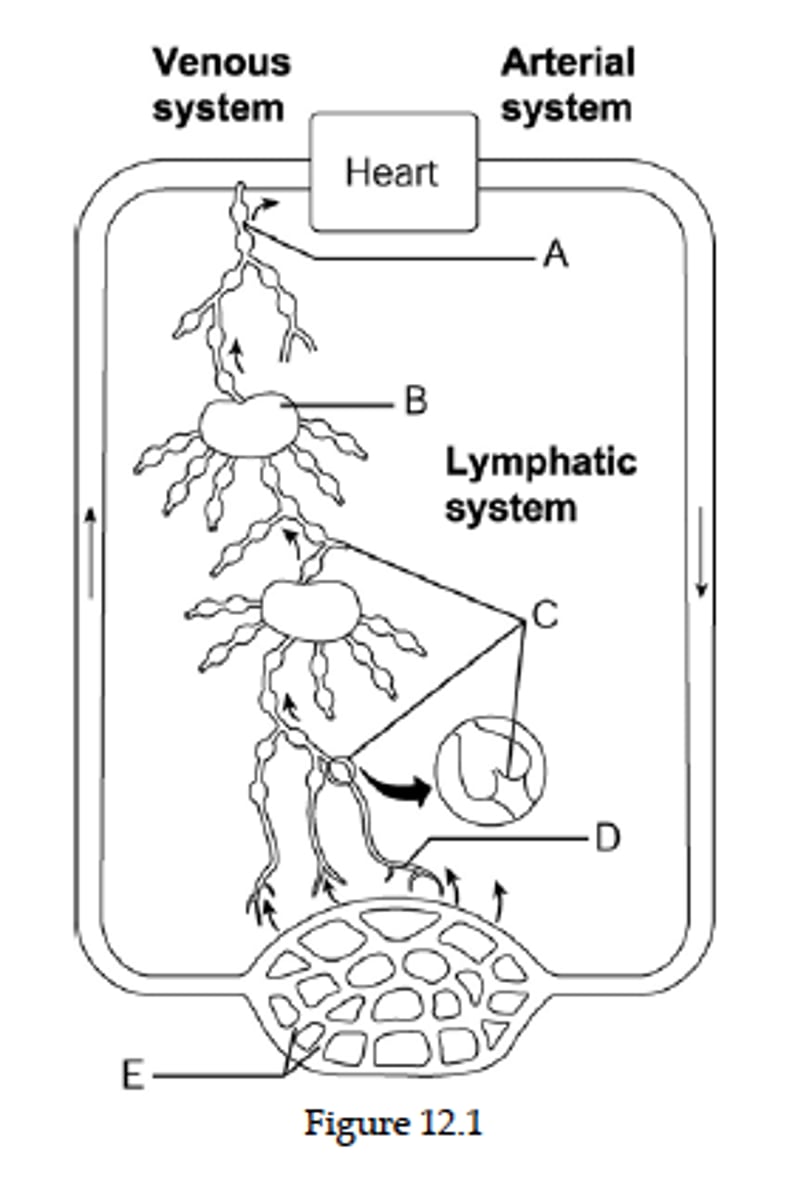
(Efferent lymphatic) (see back of card)
AIDS cripples the immune system by interfering with the activity of cells called
__________.
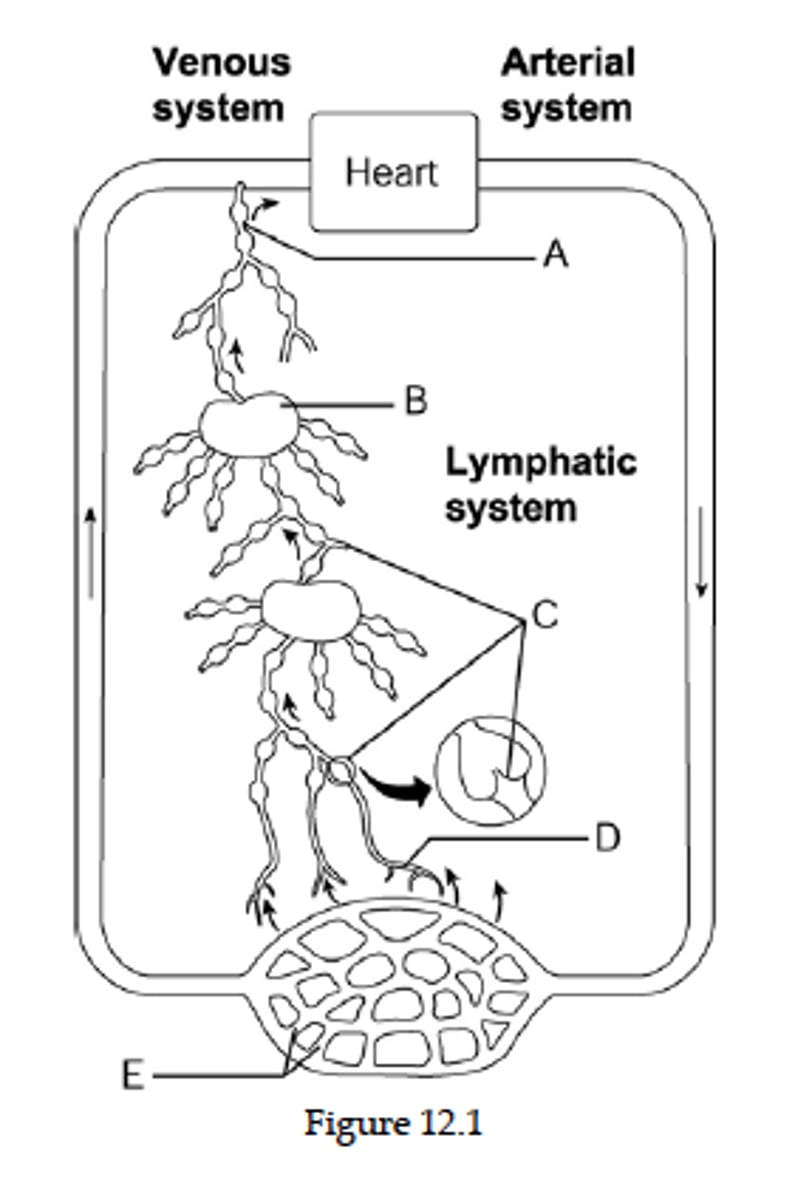
(Helper T cells) (see back of card)
The lymphoid tissues that trap and remove bacteria that enter the throat are indicated by
letter __________.
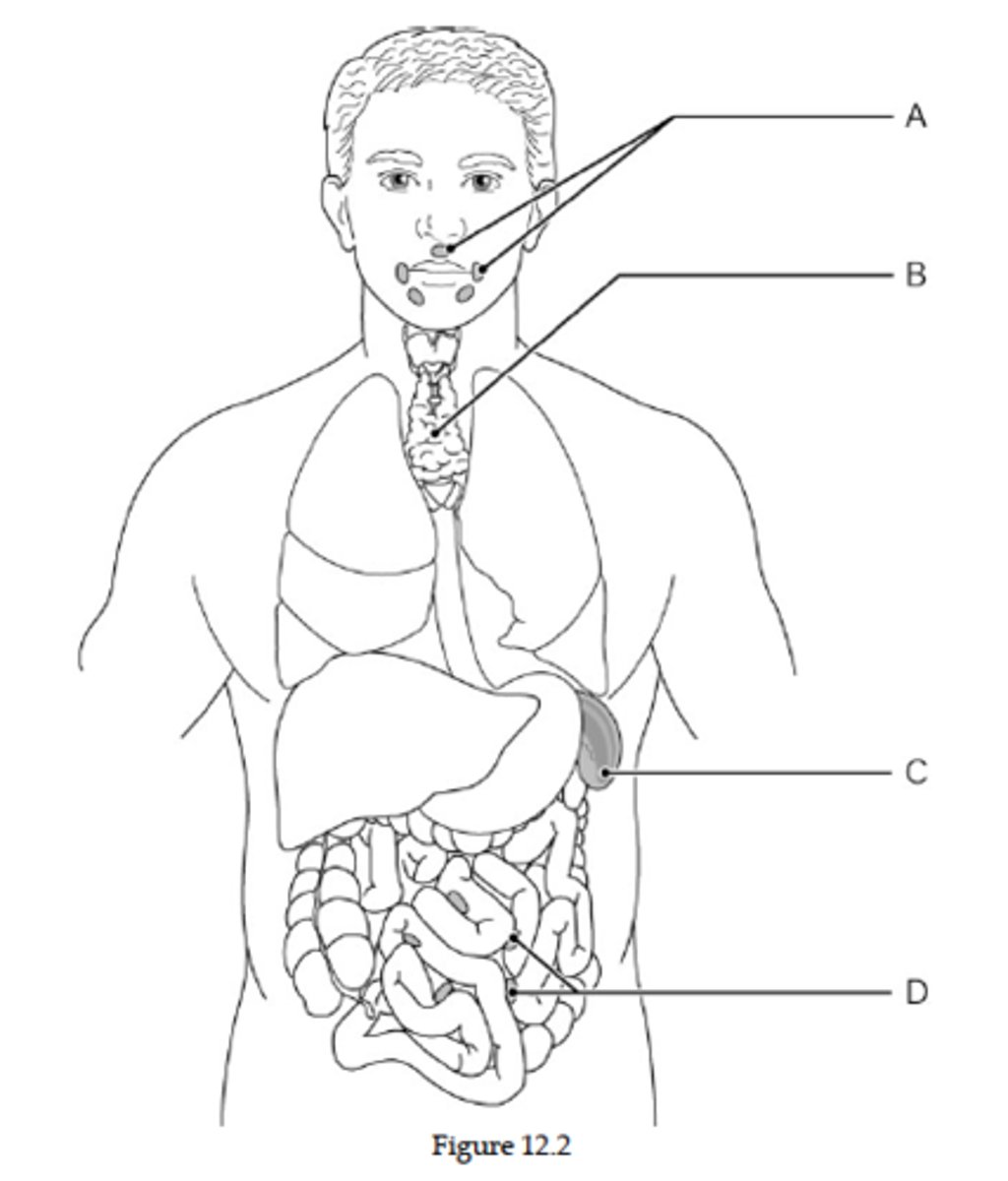
(A) (see back of card)
(I will flip the cards back)
One effect of complement fixation that causes the cell membranes of foreign cells to
become sticky so that they are easier to phagocytize is called __________.
Opsonization
A tropical disease that results when parasitic worms clog the lymphatic vessels is called
__________.
Elephantiasis
The clumping of foreign cells, a type of antigen-antibody reaction, is called __________.
Agglutination
(I am flipping the cards back to include pictures)
The spleen is indicated by letter __________.
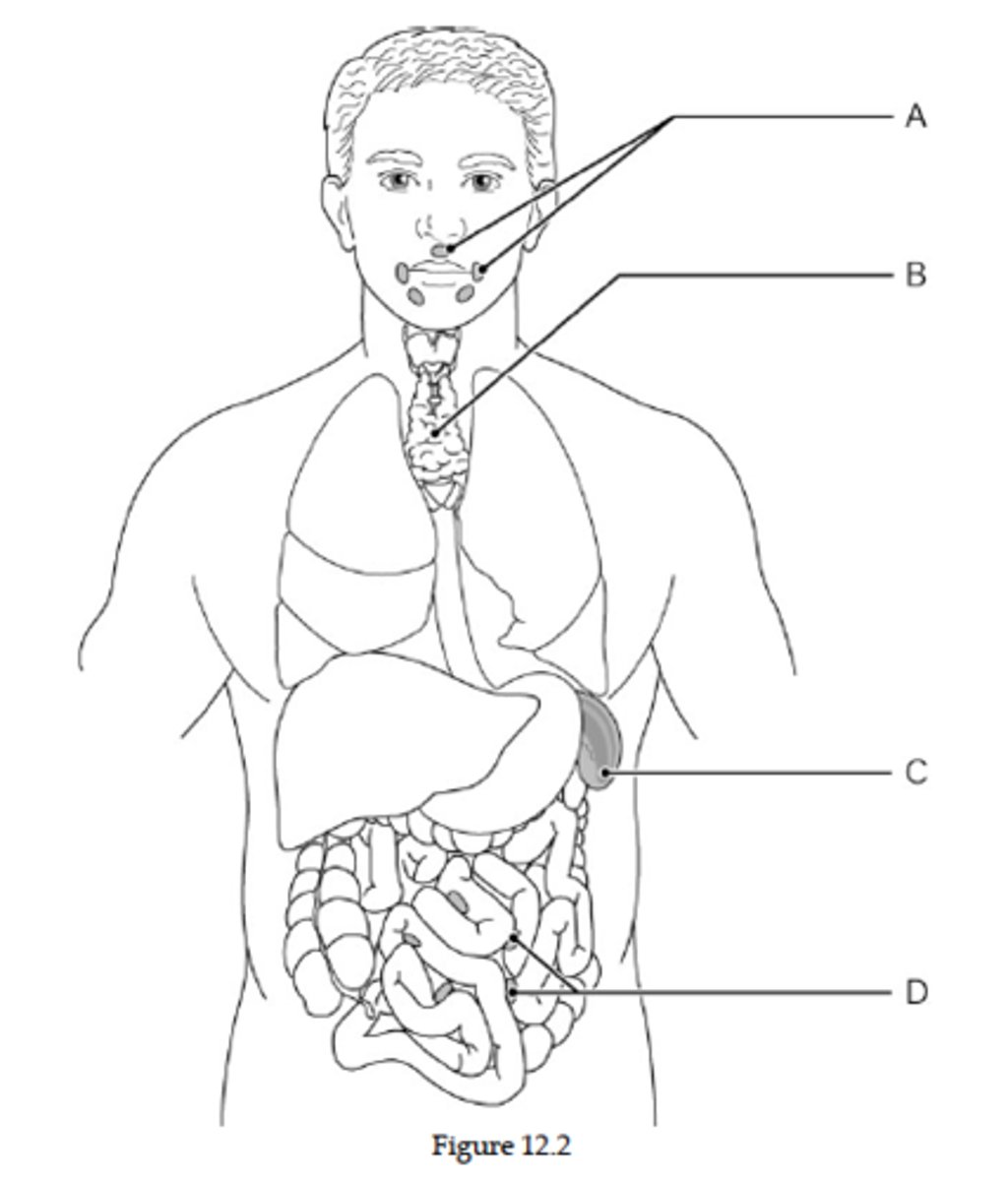
(C) (see back of card)
(I am flipping the cards back )
(T/F) The final disposal of cell debris as inflammation subsides is performed by neutrophils.
False
(T/F) The thymus gland, found around the trachea, programs certain lymphocytes.
False
(T/F) Memory cells are descendants of an activated B or T cell.
True
(T/F) The nonspecific defense by which complement proteins attach to sugars or proteins on the
surface of foreign cells is called complement fixation.
True
(T/F) Lymph in the right arm is returned to the heart via the right lymphatic duct.
True
Fever is a systemic response triggered by pyrogens
True
Allografts are tissue grafts taken from an unrelated person.
True
Like all blood cells, lymphocytes originate from hemocytoblasts contained within red bone
marrow.
True
The process that occurs when antibodies clump foreign cells is called agglutination.
True
Antibodies are also referred to as immunoglobulins.
True
Our immune system can be affected by severe stress.
True
Artificially acquired passive immunity is conferred when one receives immune serum for
poisonous snake bites.
True
Extremely weakened pathogens that are still alive are attenuated.
True
The tonsils, spleen, thymus gland, and Peyerʹs patches are referred to as mucosa-associated
lymphatic tissue (MALT)
False
The antibody a mother passes to her fetus is IgM.
False